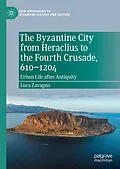"This is a most welcome and important contribution in the study of Byzantine cities, a topic of growing scholarly interest. Drawing from a range of historical sources and archaeological results, this book offers a compelling overview of the socioeconomic and cultural complexity of the Byzantine city and its significance for our understanding of the history of Byzantium."
-Nikolas Bakirtzis, The Cyprus Institute"This magisterial book explores the Byzantine city from two different points of view: its concrete archaeological image, deriving from excavation in many different Mediterranean countries; and our contemporary idea of it, produced by the intense scholarly debate of the last few decades. Based on extensive reading, and a sophisticated review and discussion of the most relevant theoretical themes, Zavagno's study is a crucial reference for everyone willing to study and understand the complexity of urban phenomenon in the Byzantine Mediterranean."
-Enrico Zanini, University of Siena, Italy
This book therefore examines the regional and subregional trajectories in the urban function, landscape, structure and fabric of Byzantium's cities, synthesizing the most cutting-edge archaeological excavations, the results of analyses of material culture (including ceramics, coins, and seals) and a reassessment of the documentary and hagiographical sources. The transformation the Byzantine urban landscape underwent from the seventh to thirteenth centuries can afford us a better grasp of changes to the Byzantine central and provincial administrative apparatus; their fiscal machinery, military institutions, socio-economic structures and religious organization. This book will be of interest to students and researchers of the history, archaeology and architecture of Byzantium.
Luca Zavagno is Associate Professor of Byzantine Studies in the Department of History at Bilkent University, Turkey. He is the author of many articles on the early medieval and Byzantine Mediterranean, as well as two monographs.
Autorentext
Luca Zavagno is Associate Professor of Byzantine Studies in the Department of History at Bilkent University, Turkey. He is the author of many articles on the early medieval and Byzantine Mediterranean, as well as two monographs.
Klappentext
This book explores the Byzantine city and the changes it went through from 610 to 1204. Throughout this period, cities were always the centers of political and social life for both secular and religious authorities, and, furthermore, the focus of the economic interests of local landowning elites.
This book therefore examines the regional and subregional trajectories in the urban function, landscape, structure and fabric of Byzantium's cities, synthesizing the most cutting-edge archaeological excavations, the results of analyses of material culture (including ceramics, coins, and seals) and a reassessment of the documentary and hagiographical sources. The transformation the Byzantine urban landscape underwent from the seventh to thirteenth centuries can afford us a better grasp of changes to the Byzantine central and provincial administrative apparatus; their fiscal machinery, military institutions, socio-economic structures and religious organization. This book will be of interest to students and researchers of the history, archaeology and architecture of Byzantium.
Inhalt
1. The History of Byzantine Urbanism.- 2. The Byzantine Mediterranean Between the End of Late Antiquity and the Fourth Crusade.- 3. The Experience of Byzantine Cities Across Space and Time.- 4. "Regional" Changes of Byzantine Urbanism from 600 to 1204.
